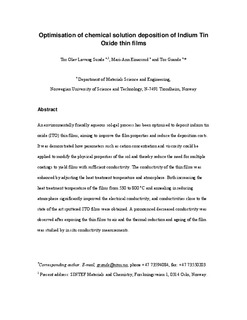| dc.contributor.author | Sunde, Tor Olav Løveng | |
| dc.contributor.author | Einarsrud, Mari-Ann | |
| dc.contributor.author | Grande, Tor | |
| dc.date.accessioned | 2015-01-08T11:03:05Z | |
| dc.date.accessioned | 2015-01-29T14:14:13Z | |
| dc.date.available | 2015-01-08T11:03:05Z | |
| dc.date.available | 2015-01-29T14:14:13Z | |
| dc.date.issued | 2014-12-31 | |
| dc.identifier.citation | Thin Solid Films 2014, 573:48-55 | nb_NO |
| dc.identifier.issn | 0040-6090 | |
| dc.identifier.uri | http://hdl.handle.net/11250/275042 | |
| dc.description | This is the author’s final, accepted and refereed manuscript to the article. | nb_NO |
| dc.description.abstract | An environmentally friendly aqueous sol–gel process has been optimised to deposit indium tin oxide (ITO) thin films, aiming to improve the film properties and reduce the deposition costs. It was demonstrated how parameters such as cation concentration and viscosity could be applied to modify the physical properties of the sol and thereby reduce the need for multiple coatings to yield films with sufficient conductivity. The conductivity of the thin films was enhanced by adjusting the heat treatment temperature and atmosphere. Both increasing the heat treatment temperature of the films from 530 to 800 °C and annealing in reducing atmosphere significantly improved the electrical conductivity, and conductivities close to the state of the art sputtered ITO films were obtained. A pronounced decreased conductivity was observed after exposing the thin films to air and the thermal reduction and ageing of the film was studied by in situ conductivity measurements. | nb_NO |
| dc.language.iso | eng | nb_NO |
| dc.publisher | Elsevier | nb_NO |
| dc.title | Optimisation of chemical solution deposition of Indium Tin Oxide thin films | nb_NO |
| dc.type | Journal article | nb_NO |
| dc.type | Peer reviewed | en_GB |
| dc.date.updated | 2015-01-08T11:03:05Z | |
| dc.source.volume | 573 | nb_NO |
| dc.source.journal | Thin Solid Films | nb_NO |
| dc.identifier.doi | http://dx.doi.org/10.1016/j.tsf.2014.10.093 | |
| dc.identifier.cristin | 1193042 | |

